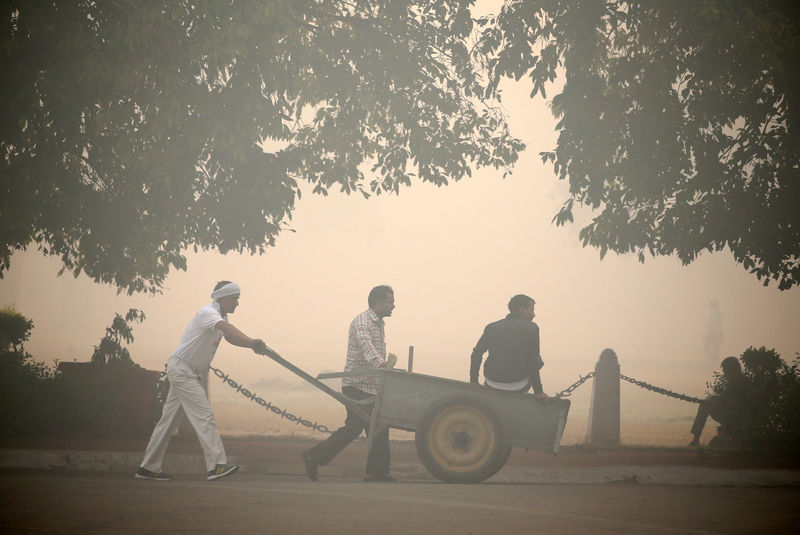(Bloomberg Opinion) -- Over the weekend, India’s Supreme Court pronounced on a title dispute in Ayodhya, a small town in India’s northern state of Uttar Pradesh. Like many other property cases in India, this one had been working its way through the judicial system for decades. But it may be the most consequential such dispute in Indian history.
Millions of Hindus believe Ayodhya was the capital of Ram, an avatar of Vishnu and hero of the epic Ramayana, and the dispute was over rights to the site where Hindus say a 16th century mosque was built over Ram’s birthplace. Reversing a lower court’s order that the area be divided between the two sides, judges awarded it entirely to the Hindu applicants, while saying Muslims must be compensated with land elsewhere.
The dispute is inextricably entwined with national politics and the status of Indian secularism. It exploded into the national consciousness in the 1980s and early 1990s, when both the then-ruling Indian National Congress party and today’s ruling Bharatiya Janata Party laid claim to Ram’s heritage. Congress Prime Minister Rajiv Gandhi had the locks on the mosque broken open and began an election campaign from the town.
Meanwhile, BJP leaders launched a nationwide “rath yatra” -- a pilgrimage in a bus decked out to look like a chariot -- intending to gather support for replacing the mosque with a Hindu temple. (One of the local organizers of the rath yatra was a young man named Narendra Modi.) Finally, amid the escalating tensions, a mob of Hindu activists physically demolished the medieval mosque in 1992 as the state police -- controlled by the local BJP administration -- stood by or ran away. That defiant act of violence marked the beginning of the long rise of the BJP to absolute power in India.
Today, after the Supreme Court awarded the BJP-run central government the right to set up a trust to administer the process of Hindu worship at this long-disputed site, it is worth noting how effectively and efficiently Modi’s party has moved forward on the core aspects of its ideological agenda. For decades, the Hindu nationalist wing of Indian politics has mobilized around certain key issues: the banning of cow slaughter, the building of a temple at Ayodhya, combating the perceived demographic threat to Hindus from migration or conversion, and denying autonomy to India’s Muslim-majority state of Jammu and Kashmir.
On each of these, in just the few months since Modi was reelected as prime minister with an enhanced majority earlier this year, there has been significant progress. A temple will be built at Ayodhya; Kashmir has had its special status revoked; a project to disenfranchise all “foreigners” in the border state of Assam has been concluded and may be extended to the rest of India. A national law effectively banning religious conversion may not be far off, while violence from self-styled “cow protectors” has also been widely publicized.
The speed and energy with which the BJP’s social agenda has been implemented stands in sharp contrast to the dilatory and timid approach the government has taken to structural economic reform. When Modi was first elected in 2014, many hoped that he would instead focus on the economy over social issues, as the BJP had done during its previous stint in power in New Delhi (remember the slogan, “build toilets before temples?”).
But the Modi government has clearly prioritized foreign affairs and domestic social change. While some major reforms have been introduced, including a new bankruptcy code and a nationwide goods-and-services tax, other long-pending measures that would improve Indian competitiveness have been postponed or avoided. Loss-making or unproductive state-owned companies have not been shut down or sold, for fear of the political fallout. This reluctance to reform has persisted in spite of a dramatic and self-inflicted economic slowdown, reflected last week in Moody’s decision to downgrade the outlook for India to negative.
The question is what Modi chooses to do after this victory. With so much progress to tout on the Hindu nationalist agenda, will he now feel he has the political space for bold economic reform? This is what many of those who continue to be optimistic about his tenure argue. And Modi himself continues to frame the government’s social program carefully, as part of the natural and impartial settling of long-pending issues rather than as the beginning of a new radical agenda.
But such hopes have been continually raised since 2014 and mostly been disappointed. The only rational conclusion is that Modi and his party feel that remaking Indian society is more important than remaking the economy. Perhaps they have been elected more on the basis of the social issues the BJP has espoused since its founding decades ago than on nebulous hopes of economic progress. Or perhaps they’re just true believers themselves.
